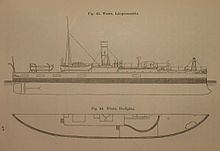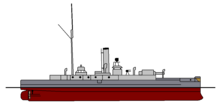Wespe-class gunboat
 SMS Natter
| |
| Class overview | |
|---|---|
| Name | Wespe class |
| Builders | AG Weser, Bremen |
| Operators | Imperial German Navy |
| Built | 1875–1881 |
| In service | 1885–1912 |
| In commission | 1876-1900 |
| Completed | 11 |
| General characteristics | |
| Displacement | 1,109 t (1,091 long tons)[1] |
| Length | 43.50 m (142 ft 9 in)[1] |
| Beam | 10.65 m (34 ft 11 in)[1] |
| Draught | 3.10 m (10 ft 2 in)[1] |
| Depth of hold | 4.10 m (13 ft 5 in)[1] |
| Installed power | PSi/700 |
| Propulsion | 4 Boilers
2 × 2-cylinder compound engines |
| Speed | 9.0 knots (16.7 km/h; 10.4 mph) |
| Complement | 76–88 |
| Armament | 1 * 30.5 cm MRK L/22
2 * torpedo tubes ∅ 35 cm After 1883 also: 2 × 8.7 cm RK L/24
2 × Rev 3.7 cm Hotchkiss |
| Armour | |
The Wespe-class gunboats were a class of 11 armored gunboats of the Imperial German Navy. They were meant for the defence of the North Sea coast. AG Weser in Bremen built them between 1874 and 1881. The boats were often in reserve or used for training purposes.
Context
[edit]Technical developments
[edit]In Germany, the first plans for coastal defense centered on the use of monitors, e.g. SMS Arminius of about 1,800 t. When the torpedo was developed, the use of such big warships seemed unnecessary. Smaller vessels to defend the torpedo barriers seemed enough.[2]
Local circumstances
[edit]The German Baltic Sea coast did not require gunboats. Here, all but two of the harbors had parallel moles. These stretched into the sea on both sides of the fairway. With torpedo barriers and heavy coastal batteries to protect these, it was thought unnecessary to have gunboats to keep the enemy at bay.[3] (Later on, the actual stations of the Wespe class seemed to contradict these ideas.[4])
On the German North Sea coast and the east coast of Schleswig-Holstein the situation was quite different. Here the Eider, Elbe, Weser, Jade, and Ems exited into shallow waters with many shoals and islands. If the enemy could pass the outer limits of these shallow waters, he could safely anchor and prepare an attack or landing.[3] Vessels defending these areas therefore needed a shallow draught. They also had to defend the local torpedo barriers. Here, these had to be so far from the coast that they could not to be defended by coastal artillery.[5]
Armored or unarmored
[edit]
After concluding that on the North Sea coast, monitors of about 2,000 t could be replaced by much smaller vessels, the next question was whether these small vessels should be armored or not. England, Denmark, the Netherlands, Sweden and Russia opted for unarmored gunboats.[2] Germany opted for bigger, armored gunboats.
The 'unarmored' school of thought proposed small unarmored gunboats with a single heavy gun. It noted that in these circumstances, these boats offered a small target, while their guns could penetrate up to 20 cm (7.9 in) of armor at medium distances. Due to their very shallow draught, these small gunboats could also evade ram attacks. A further advantage was the limited cost of these boats. Which of course also meant that one could buy more of these.[5] This led to the Ant-class gunboats of about 250 t and the Ever-class gunboats of 200 t.
The German Navy school of thought said that an unarmored vessel could only be useful when it was covered by natural heights or a mole. In all other circumstances, it risked swift destruction. The threat by enemy capital ships was of course obvious. A less obvious threat was that posed by steam launches (Dampfbeibooten). These of course had much smaller guns, but these light guns were sufficient to destroy unarmored ships. These light guns were also much more in line with the size of the vessel on which they were mounted. This caused that the launches were way more stable at sea, relating in a far higher chance to hit the target.[5]
Development
[edit]
After the German Navy opted for armored gunboats, it could issue some specifications for new gunboats. The navy required the use of a gun that could penetrate 20 cm of armor, even at long distances. In turn, the boats should themselves also be protected 20 cm of armor. The gunboats should furthermore be seaworthy and have a shallow draught. The navy required only a limited speed for the vessels.[6]
The Wespe-class gunboats were built by AG Weser in Bremen. Wespe, Viper, and Biene were launched in 1876. Mücke and Skorpion were launched in 1877. Basilisk and Chamäleon were launched in 1878. Krokodil was launched in 1879 and Salamander in 1880.[1]
Characteristics
[edit]Hull and armor
[edit]
The Wespe-class gunboats' hulls were made of iron. They were 43.50 metres (142 ft 9 in) long with a beam of 10.65 m (34 ft 11 in), a depth of hold of 4.10 m (13 ft 5 in), and a draught of 3.10 m (10 ft 2 in). They displaced 1,109 t.[1] They had no rigging, only a signals mast.[7]
The armor belt was 203 mm (8 in) thick. It continued at that same thickness along the whole bow section, but tapered to 102 mm (4 in) at the stern.[8] This was because the Wespes were planned to engage the enemy with their bow forward, instead of with the broadside. The deck of the Wespes was protected by a 50 mm (2 in) thick deck armor. The class also had watertight compartments and a double hull on the bottom side.[9]
On top of the armored deck, there was a light iron superstructure that served to make the boats more seaworthy. The section before the gun emplacement served as accommodation for the crew. The aft section served as quarters for the officers and non-commissioned officers. Behind the gun, there was a deckhouse, which gave a dry access to the machinery and the officer's quarters.[10]
Armament
[edit]The Wespes were armed with a 30.5 cm MRK L/22 on pivot carriage which put its trunnions 3.7 m above the water. The gun was placed behind a circular armored barbette of 203 mm (8 in) thickness.[1] The class also had a ram.[10]
Later, the Wespes got two 8.8 cm SK guns and two revolver guns. Below the waterline they got two torpedo tubes.[11]
At the time, the Wespe class combined the heaviest gun in the German navy with an armor protection that was comparable to that of many battleships. It was thought this would allow the boats to engage most enemy capital ships on distances at which most of the enemy's guns could not penetrate the boat's armor. In the coastal area, the shallow draught boats could then evade again in spite of their low speed.[12]
Propulsion
[edit]The Wespes had two separate steam engines which each drove their own propeller and were separated from each other by a watertight bulkhead.[4] Together, they produced 700 indicated horsepower (520 kW)[13] and gave the vessel a speed of 9 knots (17 km/h; 10 mph). For war, there was enough coal on board for steaming at full speed for 40 hours. More coal could be loaded for expeditions that did not require shallow draught.[10]
Cost
[edit]The total cost of a Wespe, including machinery and artillery ranged from about 1,034,018 to 1,210,316 Mark.[7]
Use
[edit]In 1881, the North Sea station had: Viper, Mücke, Skorpion, Salamander, Natter, and Wespe. The Baltic Sea station had: Basilisk, Kamäleon, Krokodil, Hummel, and Biene.[14]
Boats of the class
[edit]| Name | Laid down | Launched | First comm. | Fate |
|---|---|---|---|---|
| Wespe | 6 July 1876[15] | |||
| Viper | 21 September 1876[8] | |||
| Biene | 2 December 1876[8] | |||
| Mücke | 5 May 1877[8] | |||
| Skorpion | 17 May 1877[8] | |||
| Basilisk | 1878[16] | |||
| Chamäleion | 1878[16] | |||
| Krokodil | 1879[16] | |||
| Salamander | September 1878[17] | 6 January 1880[17] | ||
| Natter | July 1879[17] | 29 September 1880[17] | ||
| Hummel | July 1879[17] | 12 February 1881[17] |
Notes
[edit]- ^ a b c d e f g h Von Kronenfels 1881, p. 114.
- ^ a b Von Kronenfels 1881, p. 110.
- ^ a b Von Kronenfels 1881, p. 111.
- ^ a b Wislicenus 1896, p. 134.
- ^ a b c Von Kronenfels 1881, p. 112.
- ^ Von Kronenfels 1881, p. 113.
- ^ a b Von Kronenfels 1881, p. 119.
- ^ a b c d e Dislere 1877, p. 125.
- ^ Von Kronenfels 1881, p. 117.
- ^ a b c Von Kronenfels 1881, p. 118.
- ^ Wislicenus 1896, p. 133, 134.
- ^ Von Kronenfels 1881, p. 116.
- ^ Von Kronenfels 1883, p. 49.
- ^ "Wilhelmshaven, 28. August". Hannoverscher Kurier. 29 August 1881.
- ^ "Occasional Notes". Pall Mall Gazette. No. 3564. London. 21 June 1876.
- ^ a b c Barnes 1890, p. 296.
- ^ a b c d e f Hannoverscher Kurier 31 Oct 1882.
References
[edit]- Barnes, F.K. (1890). "Part II British and Foreign armoured and unarmoured ships". Brassey's Naval Annual. Portsmouth: J. Griffin and Co.
- Dislere, P. (1877). Die Panzerschiffe der neuesten Zeit. Carl Gerold's Sohn, Pola.
- Von Kronenfels, J.F. (1881). Das schwimmende Flottenmaterial der Seemächte. A. Hartleben's Verlag, Wien.
- Von Kronenfels, J.F. (1883). Das schwimmende Flottenmaterial der Seemächte, die Kriegsschiffbauten 1881-1882. Vol. Erster Ergänzungsband. A. Hartleben's Verlag, Wien.
- Wislicenus, Georg (1896). Deutschlands Seemacht: sonst und jetzt nebst einem Überblick über die Geschichte der Seefahrt aller Völker. Grunow, Leipzig.
- "Berlin, 30. Oct". Hannoverscher Kurier (in German). Hannover. 29 August 1881.
